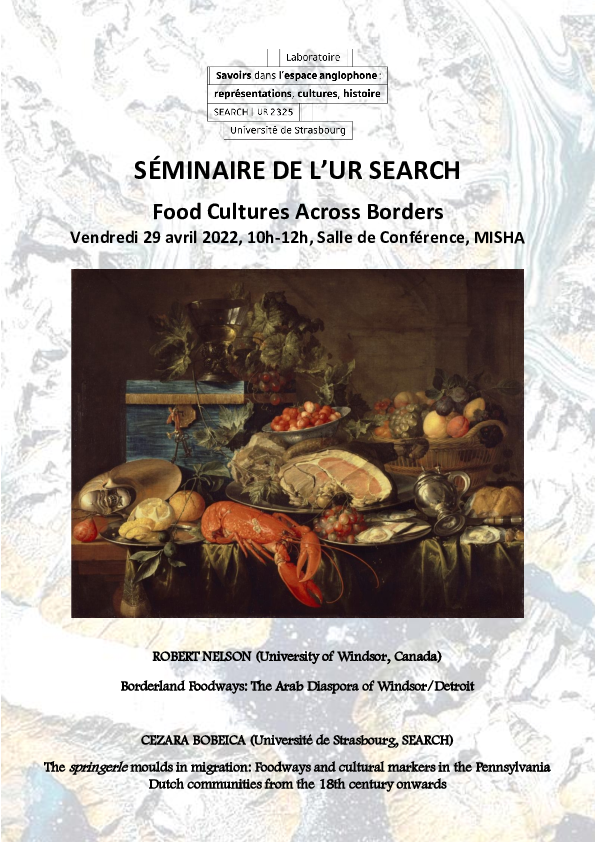Food Cultures Across Borders, Vendredi 29 avril 2022, 10h-12h, Salle de Conférence, MISHA, Campus Esplanade, Université de Strasbourg
Robert Nelson: Borderland Foodways: The Arab Diaspora of Windsor/Detroit
Virtually all North American border foodways literature focuses on the US Southwest, where an international boundary runs through an ethnic foodway. This research is enormously valuable, but Mexican food in the Southwest does not tell us much about a diasporic border food community. What do we learn when we study an international boundary running through an ethnic minority, such as the Arab community that exists on both sides of the Windsor/Detroit border? When a foodway already struggles to find its identity within a hegemonic culture, how does that food community negotiate an international state difference right in its midst? It would appear that, before 9/11, a “soft” border allowed for the existence of a large, deeply connected, regional cross-border Arab foodway. Since then, the thickening of that border has rapidly accelerated the formation of an “Arab Canadian” foodway in Windsor.
Rob Nelson is Head of the Department of History at the University of Windsor, Canada. His revised Cambridge dissertation appeared in 2011 as German Soldier Newspapers of the First World War. His first ‘food history’ publication was ‘Pitas and Passports: Arab Foodways in the Windsor-Detroit Borderlands’ Mashriq & Mahjar 6:2 (2019). Nelson has won fellowships from the Killam Trust, the Humboldt Foundation, and was a Visiting Fulbright Scholar at the City University of New York, Graduate Center.
Cezara Bobeica: The springerle moulds in migration: Foodways and cultural markers in the Pennsylvania Dutch communities from the 18th century onwards
From the mid seventeenth century onwards, many Germans, and especially Protestants and religious dissenters such as Mennonites, Quakers and Amish chose to settle in Pennsylvania. In their suitcases, they took cake boards and rolling pins used to shape aniseed-flavoured biscuits, known as springerle. The word springerle is of Alemannic origins and designates both the moulds and the biscuits. The moulds, generally carved out of pear wood, were present along the Rhine, in Alsace (France), in Germany and in Switzerland as early as the fourteenth century. What makes springerle moulds so unique is their iconography as they display scenes from the Bible, but also everyday life subjects and allegorical topics. When carried across the ocean, these moulds perpetuated the Germanic iconography of the emigrants and functioned as true cultural markers. Crafts, shops and events developed around the springerle moulds in Pennsylvania contributing thus to the recreation of a feeling of homeplace. The designs and motifs on the moulds evolved along with the adaptation of the German migrants to their new life. They are material testimonies of the Americanisation process in the German communities in Pennsylvania. I therefore intend to analyse how the material and symbolic transformations of the moulds contributed to the adaptation and transformation of the epistemological framework of the German emigrants and their gradual integration within the American community.
Cezara Bobeica defended her PhD dissertation in January 2021 at the University of Strasbourg, France. Her interest lies in the iconography and the symbolism of the Renaissance with a particular interest in emblematics. Thanks to a Fulbright Scholar Grant she received in January 2021 she pursued her research on foodways and material culture in migration in collaboration with the German Cultural Centre in Kutztown, Pennsylvania. She authored a number of articles on emblematics, with a special focus on intermediality and intertextuality.
« The motif of the phoenix in Henry Peacham’s Minerva Britanna (1612) : a political reappropriation ». Shakespeare en devenir, ISSN : 1958-9476, numéro 16, février 2022.
https://shakespeare.edel.univ-poitiers.fr/index.php?id=2703
« Channelling the meaning from the margins : the hermeneutical potential of the paratextual quotations in Henry Peacham’s Minerva Britanna (1612) », Revue XVII-XVIII, décembre 2020.
